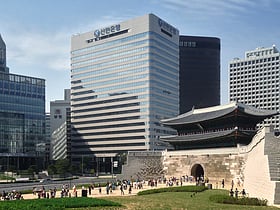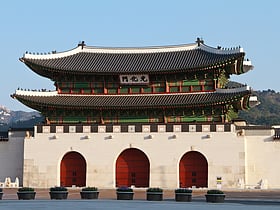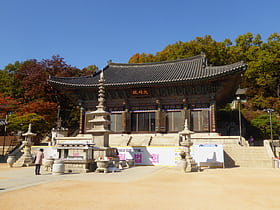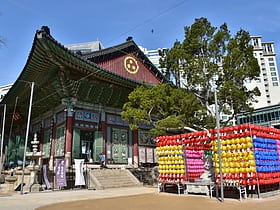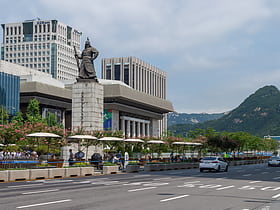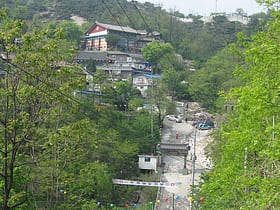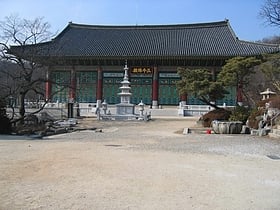Seoul: Buddhist Architecture
Places and attractions in the Buddhist architecture category
Categories
- Museum
- Neighbourhood
- Art museum
- Park
- Bridge
- History museum
- Universities and schools
- Specialty museum
- Shopping
- Historical place
- Buddhist architecture
- Temple
- Church
- Vernacular architecture
- Market
- Skyscraper
- Mountain
- Theater
- Sport
- Sport venue
- Natural attraction
- Nature
- Library
- Art gallery
- Sacred and religious sites
- Concerts and shows
- City gate
- Unesco
- Fashion museum
- Palace
- Monuments and statues
- Arenas and stadiums
- Archaeological site
- City
- Concert hall
- Nightlife
Sungnyemun
Rebuilt city gate from the 14th century Sungnyemun, also known as Namdaemun, is an iconic historical structure located in the heart of Seoul, South Korea. It stands as a proud testament to the city's rich past, being one of the Eight Gates of Seoul that surrounded the capital during the Joseon Dynasty.
Gwanghwamun
Imposing gate at Gyeongbokgung Palace Gwanghwamun is the main and largest gate of Gyeongbokgung Palace, located in Seoul, South Korea. Serving as a landmark historical site, this majestic gate stands as a proud emblem of the city's rich heritage and dynastic past.
Bongeunsa Temple
Bongeunsa Temple, nestled in the bustling city of Seoul, South Korea, offers a serene oasis amidst urban modernity. This historic Buddhist temple, dating back to the Shilla King Weongseong's reign in 794 AD, stands as a testament to the country's rich religious...
Jogyesa
Main Buddhist temple and grand main hall Jogyesa is a serene oasis of calm in the bustling heart of Seoul, South Korea. As the chief temple of the Jogye Order of Korean Buddhism, it stands as a spiritual center amidst the urban sprawl, offering a glimpse into the country's rich religious heritage.
Gwanghwamun Plaza
Gwanghwamun Plaza is a public open space that serves as a historical and cultural nexus in the heart of Seoul, South Korea. Opened to the public in 2009, the square has quickly become a key attraction for both locals and tourists, offering a serene environment amidst...
Heunginjimun
Historic gate of the Fortress Wall Heunginjimun, literally "Gate of Rising Benevolence" or more commonly known as Dongdaemun, is one of The Eight Gates of Seoul in the Fortress Wall of Seoul, a prominent landmark in central Seoul, South Korea.
Statue of Admiral Yi Sun-sin
The statue of Admiral Yi Sun-sin is located at the Sejongno, Gwanghwamun Plaza in Seoul, South Korea. It is dedicated to the 16th-century Korean war hero, admiral Yi Sun-sin. It is considered one of Seoul's major landmarks and has been called "one of the most important instances of Korean public art".
Wongaksa Pagoda
Wongaksa Pagoda is a twelve metre high ten storey marble pagoda in the center of Seoul, South Korea. It was constructed in 1467 to form part of Wongaksa temple, that King Sejo had founded two years before on the site of an older Goryeo-period temple, Heungbok-sa.
Inwangsa
Inwangsa is a Buddhist temple of the Bonwon Order in Mt. Inwangsan, Seoul, South Korea. It is located at San 2 Muak-dong, in the Jongno-gu area of the city.
Bongwonsa
Bongwon Temple is a South Korean Buddhist temple in Bongwon-dong, Seodaemun-gu, Seoul, near Yonsei University. Situated to the northeast of the university on the hillside of Ahn Mountain, this is the head temple of the Taego Order of Korean Buddhism.
Gwanghuimun
Gwanghuimun is one of The Eight Gates of Seoul in the Fortress Wall of Seoul, South Korea, which surrounded the city in the Joseon Dynasty. The gate is also known as Namsomun.
Myogaksa
Myogaksa Temple is a Korean Buddhist temple located in the heart of downtown Seoul, South Korea, in the Jongro District, nestled on the east side of Naksan Mountain. It houses the administrative headquarters of the Gwaneum Order of Korean Buddhism.
Geumseonsa
Geumseonsa is a Buddhist temple of the Jogye Order in Seoul, South Korea. Believed to have been established before 1405 it is located in 196-1 Gugi-dong in the Jongno-gu area of the city.
Sukjeongmun
Sukjeongmun is one of the Eight Gates of Seoul in the Fortress Wall of Seoul, South Korea, which surrounded the city in the Joseon Dynasty. The gate is also known as Bukdaemun. It was built north of Seoul behind Gyeongbokgung Place. It was rarely used. It was only used in ceremonious and symbolic functions.
Map

